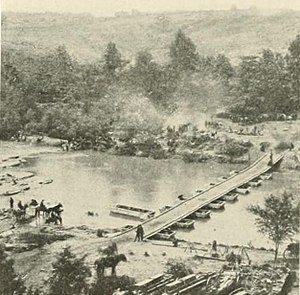| Battle of North Anna | |||||||
|---|---|---|---|---|---|---|---|
| Part of the American Civil War | |||||||
 Pontoon bridge constructed by Union engineers for crossing the North Anna River | |||||||
| |||||||
| Belligerents | |||||||
|
|
| ||||||
| Commanders and leaders | |||||||
|
|
| ||||||
| Units involved | |||||||
|
| |||||||
| Strength | |||||||
| 67,000–100,000[2] | 50,000–53,000[2] | ||||||
| Casualties and losses | |||||||
|
3,986 total (591 killed; 2,734 wounded; 661 captured/missing)[3][4] |
1,552 (124 killed, 704 wounded, 724 missing/captured)[5] | ||||||
The Battle of North Anna was fought May 23–26, 1864, as part of Union Lt. Gen. Ulysses S. Grant's Overland Campaign against Confederate Gen. Robert E. Lee's Army of Northern Virginia. It consisted of a series of small actions near the North Anna River in central Virginia rather than a general engagement between the armies. The individual actions are sometimes separately known as: Telegraph Road Bridge and Jericho Mills (for actions on May 23); Ox Ford, Quarles Mill, and Hanover Junction (May 24).
After disengaging from the stalemate at Spotsylvania Court House, Grant moved his army to the southeast, hoping to lure Lee into battle on open ground. He lost the race to Lee's next defensive position south of the North Anna River, but Lee needed to figure out Grant's intention and initially prepared no significant defensive works. On May 23, the Union V Corps under Maj. Gen. Gouverneur K. Warren forded the river at Jericho Mills, and a Confederate division from the corps of Lt. Gen. A.P. Hill was unable to dislodge its beachhead. The II Corps under Maj. Gen. Winfield S. Hancock stormed a small Confederate force at "Henagan's Redoubt" to seize the Chesterfield Bridge crossing on the Telegraph Road but did not advance further south across the river.
That night, Lee and his engineers devised a scheme for defensive earthworks in the shape of an inverted "V" that could split the Union army when it advanced and allow the Confederates to use interior lines to attack and defeat one wing, preventing the other wing from reinforcing it in time. The Union army initially fell into this trap. As Hancock's men failed to carry the Confederate works on the eastern leg of the V on May 24, a brigade under the drunken Brig. Gen. James H. Ledlie was repulsed from an ill-conceived assault against a strong position at Ox Ford, the apex of the V. Unfortunately for the Confederates, Lee was disabled with heart issues, and none of his subordinates were able to execute his planned attack. Civil war historian Gary Gallagher mentions this as the one time General Lee's health directly affected the course of a battle. It is often argued that these health issues caused questionable decisions at Gettysburg. Still, Gallagher makes the point that Lee was a very aggressive-minded general and that his actions at Gettysburg were typical of this mindset.
After two days of skirmishing in which the armies stared at each other from their earthworks, the inconclusive battle ended when Grant ordered another wide movement to the southeast, toward the crossroads at Cold Harbor.
- ^ This Army Corps was under direct orders of Lieut. Gen. Ulysses S. Grant until May 24, 1864, when it was assigned to the Army of the Potomac. See: Official Records, Series I, Volume XXXVI, Part 1, page 113 (note at the bottom of the page).
- ^ a b Kennedy, p. 289, cites 68,000 Union, 53,000 Confederate. Grimsley, pp. 138, cites 67,000 Union, 51–53,000 Confederate. Jaynes, p. 130, cites Union effectives of 56,124, indicating that Sheridan's cavalry was absent and not included. Cullen, p. 39, cites 100,000 Union, 50,000 Confederate.
- ^ Return of Casualties in the Union forces, Battle of North Anna, Pamunkey, and Totopotomoy, May 22-June 1, 1864 (Total Army of the Potomac): Official Records, Series I, Volume XXXVI, Part 1, page 164.
- ^ Kennedy, p. 289, cites 2,623. Salmon, p. 288, cites Union casualties of 2,600. Luebke cites 1,973 Union (223 killed, 1,460 wounded, 290 captured/missing) and 2,017 Confederate (304 killed, 1,513 wounded, 200 captured/missing).
- ^ Young, p. 238, cites Confederate casualties including the actions at Guinea Station and Milford Station. Salmon, p. 288, cites 1,800 total Confederate casualties. Luebke cites 2,017 (304 killed, 1,513 wounded, 200 captured/missing).